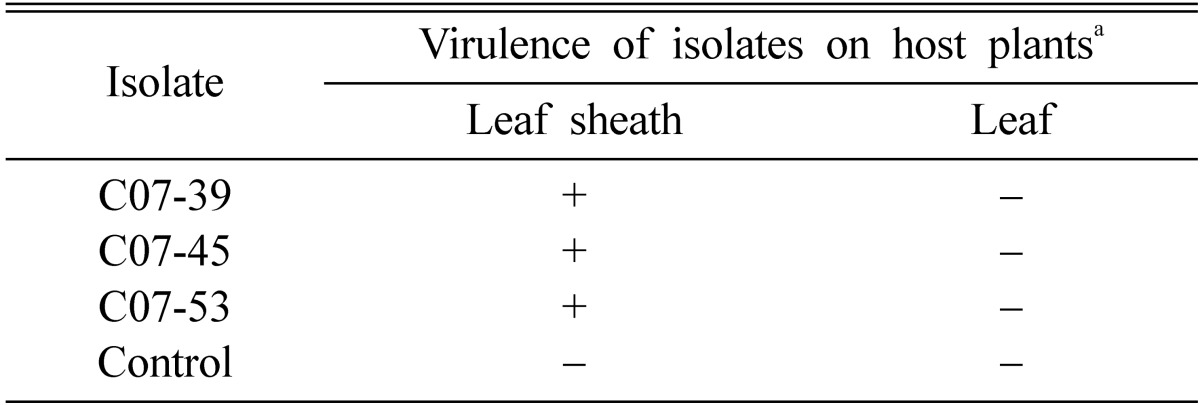Abstract
Anthracnose occurred frequently on leaf sheaths of Welsh onions grown in Gangwha island, Korea in November, 2007. The disease incidence was as high as 30% in five fields investigated. A total of 20 single spore isolates of Colletotrichum species were obtained from the affected plants, and all the isolates were identified as Colletotrichum circinans based on their morphological and cultural characteristics. Three isolates of the fungus caused anthracnose symptoms on the leaf sheaths of Welsh onions by artificial inoculation, which were similar to those observed during the field survey. In this study, the mycological and pathological characteristics of C. circinans identified as causing anthracnose of Welsh onions are clarified.
Keywords: Anthracnose, Colletotrichum circinans, Pathogenicity, Welsh onion
Welsh onion (Allium fistulosum L.) is widely grown in the temperate and subtropical regions of the world. The plant is cultivated commonly in Korea and it is an important vegetable for cooking. Anthracnose symptoms were observed frequently on leaf sheaths of Welsh onions grown in Gangwha island, Korea, during a disease survey performed in November, 2007. The symptoms appeared as irregular black spots on the leaf sheaths, and the infected leaf sheaths were blighted (Fig. 1A and 1B). Grayish conidial masses were produced sometimes on the black spots. Eight fields of Welsh onion were investigated for the disease occurrence. The incidence of the disease reached as high as 30% in five fields investigated. The disease did not occur in the other fields investigated.
Fig. 1.
Anthracnose symptoms on Welsh onion plants observed in the field. A and B, irregular black spots on the blighted leaf sheaths.
A total of 20 single spore isolates of Colletotrichum species were obtained from anthracnose symptomatic leaf sheaths of the Welsh onions. Morphological and cultural characteristics of the isolates were examined for identification purposes. All the isolates were identified as Colletotrichum circinans (Berk.) Voglino. The morphological characteristics of C. circinans we examined were similar to those described by Sutton (1992) (Table 1).
Table 1.
Morphological characteristics of Colletotrichum circinans isolated from leaf sheaths of Welsh onion

Colonies of C. circinans grown on potato dextrose agar (PDA) had dark brown with grayish aerial mycelia. Globose to pulvinate or irregular sclerotia and setae were produced abundantly on the surface of colonies (Fig. 2A). Setae produced on lesions were dark brown to black, 1~5 septate and measured 32.5~177.5 × 3.0~7.0 (Fig. 2B). Conidia were falcate, fusiform, gradually tapered to each end and measured 16.5~27.5 × 3.0~4.5 µm (Fig. 2C). Appressoria were brown to dark brown, globose to clavate, lobed to irregular and measured 6.5~15.0 × 5.0~7.5 µm (Fig. 2D). The temperature range and optimum temperature for mycelial growth of the fungus on PDA were 10~35℃ and 26~28℃, respectively.
Fig. 2.
Morphological and cultural features of Colletotrichum circinans isolated from leaf sheaths of Welsh onion. A, a 20-day-old colony grown on PDA at 24℃; B, setae on the lesions (scale bar = 40 µm); C, conidia (scale bar = 20 µm); D, appressoria (scale bar = 20 µm).
Three isolates of C. circinans were tested for pathogenicity to leaf sheaths and leaves of Welsh onion (cultivar Seokchangoedaepa) by artificial inoculation with conidial suspensions (1~2 × 106 conidia/ml) which were prepared from 20-day-old PDA cultures. Inoculations were performed by dropping 20 µl of conidial suspensions onto each sigment (25 cm in length) of leaf sheaths and leaves of 5-month-old Welsh onion in the humid plastic boxes (39 × 32 × 14 cm). The same quantity of sterile distilled water was used as the control. The plastic boxes were placed in an incubator at 26℃ for five days. Disease ratings were made based on the degree of anthracnose symptoms induced on the leaf sheaths and leaves five days after inoculation. The inoculation test was performed in three independent replicates.
All of the tested isolates of C. circinans induced anthracnose symptoms on the leaf sheaths following artificial inoculation but not on the leaves (Table 2). The symptoms were similar to those observed during the field survey. The fungal species was re-isolated from the affected areas.
Table 2.
Pathogenicity of Colletotrichum circinans isolates on Welsh onion plants by artificial inoculation

aDisease severity was rated five days after inoculation. +, anthracnose lesions produced; -, no symptom.
C. circinans was previously recorded as Colletotrichum dematium (Pers.) Grove f. circinans (Berk.) Arx, which is specific to Alliums spp. (Arx, 1957; Arx, 1970; Arx, 1981). However, Sutton (1992) described C. circinans as a distinct species from C. dematium. It has been reported that the fungus causes smudge or leaf spot of Allium spp. (Farr et al., 1989). The fungus is also recorded as an anthracnose pathogen of onion and Welsh onion in Korea (Cho and Shin, 2004). However, there has been no detailed report on mycological and pathological characteristics of C. circinans causing anthracnose of the plants. In this study, mycological and pathological characteristics of C. circinans causing anthracnose of Welsh onion were clarified.
References
- 1.von Arx JA. Die Arten der Gattung Colletotrichum Cda. Phytopath Z. 1957;29:413–468. [Google Scholar]
- 2.von Arx JA. A Revision of the Fungi Classified as Gloeosporium. Lehre, Germany: J Cramer; 1970. [Google Scholar]
- 3.von Arx JA. The Genera of Fungi Sporulating in Pure Culture. 3rd edition. Vaduz, Germany: J Cramer; 1981. [Google Scholar]
- 4.Cho WD, Shin HD. List of Plant Diseases in Korea. Fourth edition. Suwon, Korea: The Korean Society of Plant Pathology; 2004. [Google Scholar]
- 5.Farr DF, Bills GF, Chamuris GP, Rossman AY. Fungi on Plants and Plant Products in the United States. St. Paul, Minnesota, USA: APS Press; 1989. [Google Scholar]
- 6.Sutton BC. The genus Glomerella and its anamorph Colletotrichum. In: Bailey JA, Jeger MJ, editors. Colletotrichum: Biology, Pathology and Control. Wallingford, Oxon, UK: CAB International; 1992. pp. 1–26. [Google Scholar]




